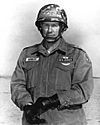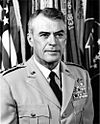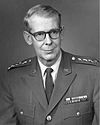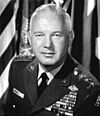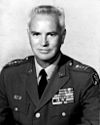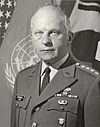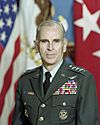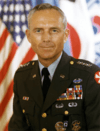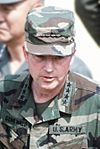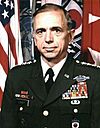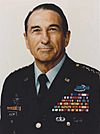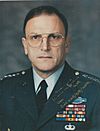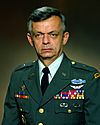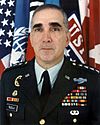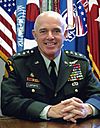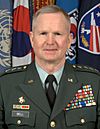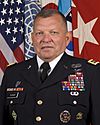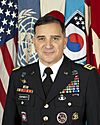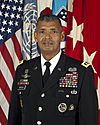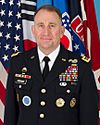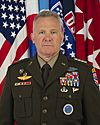United States Forces Korea facts for kids
Quick facts for kids United States Forces Korea주한 미군 |
|
|---|---|
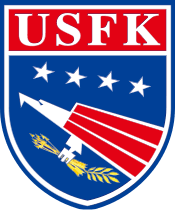
USFK
|
|
| Active | 1 July 1957 – present |
| Country | |
| Type | Subordinate Unified Command |
| Size | 23,468 personnel |
| Part of | United States Indo-Pacific Command |
| Headquarters | Camp Humphreys, Pyeongtaek, South Korea |
| Nickname(s) | USFK |
| Commanders | |
| Current commander |
|
| Deputy Commander | |
| Notable commanders |
GEN Vincent K. Brooks GEN George Decker GEN Hamilton H. Howze GEN John W. Vessey Jr. GEN John A. Wickham Jr. |
| Insignia | |
| Distinctive unit insignia | 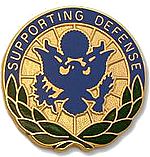 |
| Flag | 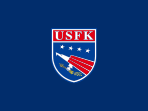 |
| United States Forces Korea | |
| Hangul | |
|---|---|
| Hanja | |
| Revised Romanization | Juhanmigun |
| McCune–Reischauer | Chuhanmigun |
United States Forces Korea (USFK) is a sub-unified command of United States Indo-Pacific Command (USINDOPACOM). USFK is the joint headquarters for U.S. combat-ready fighting forces and components under the ROK/US Combined Forces Command (CFC) – a supreme command for all of the South Korean and US ground, air, sea and special operations component commands. Major USFK elements include U.S. Eighth Army (EUSA), U.S. Air Forces Korea (Seventh Air Force), U.S. Naval Forces Korea (CNFK), U.S. Marine Forces Korea (MARFORK) and U.S. Special Operations Command Korea (SOCKOR). It was established on July 1, 1957.
Its mission is to support the United Nations Command (UNC) and Combined Forces Command by coordinating and planning among U.S. component commands, and exercise operational control of U.S. forces as directed by United States Indo-Pacific Command.
USFK has Title 10 authority, which means that USFK is responsible for organizing, training and equipping U.S. forces on the Korean Peninsula so that forces are agile, adaptable and ready.
With 28,500 American soldiers, sailors, airmen and Marines in South Korea, U.S. forces in South Korea are a major presence in the region and a key manifestation of the U.S. government's aim to rebalance toward the Asia-Pacific. The USFK mission also includes planning non-combatant evacuation operations to ensure that if the need arises, U.S. and other previously agreed-upon countries' citizens are removed from harm's way. To this end, USFK conducts routine exercises to ensure that this process is effective, efficient, and orderly.
With the relocation of the new USFK and UNC headquarters to Camp Humphreys (in Pyeongtaek) on 29 June 2018, the USFK command and the majority of its subordinate units have officially moved out of the city of Seoul; now 35 km (22 mi) further south.
Commanders, U.S. Forces Korea
| No. | Commander | Term | Service branch | |||
|---|---|---|---|---|---|---|
| Portrait | Name | Took office | Left office | Term length | ||
| 1 | General George Decker (1902–1980) |
1 July 1957 | 30 June 1959 | 1 year, 364 days |  U.S. Army |
|
| 2 | General Carter B. Magruder (1900–1988) |
1 July 1959 | 30 June 1961 | 1 year, 364 days |  U.S. Army |
|
| 3 | General Guy S. Meloy (1903–1968) |
1 July 1961 | 31 July 1963 | 2 years, 30 days |  U.S. Army |
|
| 4 | General Hamilton H. Howze (1908–1998) |
1 August 1963 | 15 June 1965 | 1 year, 318 days |  U.S. Army |
|
| 5 | General Dwight E. Beach (1908–2000) |
16 June 1965 | 31 August 1966 | 1 year, 76 days |  U.S. Army |
|
| 6 | General Charles H. Bonesteel III (1909–1977) |
1 September 1966 | 30 September 1969 | 3 years, 29 days |  U.S. Army |
|
| 7 | General John H. Michaelis (1912–1985) |
1 October 1969 | 31 August 1972 | 2 years, 335 days |  U.S. Army |
|
| 8 | General Donald V. Bennett (1915–2005) |
1 September 1972 | 31 July 1973 | 333 days |  U.S. Army |
|
| 9 | General Richard G. Stilwell (1917–1991) |
1 August 1973 | 8 October 1976 | 3 years, 68 days |  U.S. Army |
|
| 10 | General John W. Vessey Jr. (1922–2016) |
8 October 1976 | 10 July 1979 | 2 years, 275 days |  U.S. Army |
|
| 11 | General John A. Wickham Jr. (born 1928) |
10 July 1979 | 4 June 1982 | 2 years, 329 days |  U.S. Army |
|
| 12 | General Robert W. Sennewald (born 1929) |
4 June 1982 | 1 June 1984 | 1 year, 363 days |  U.S. Army |
|
| 13 | General William J. Livsey (1931–2016) |
1 June 1984 | 25 June 1987 | 3 years, 24 days |  U.S. Army |
|
| 14 | General Louis C. Menetrey Jr. (1929–2009) |
25 June 1987 | 26 June 1990 | 3 years, 1 day |  U.S. Army |
|
| 15 | General Robert W. RisCassi (born 1936) |
26 June 1990 | 15 June 1993 | 2 years, 354 days |  U.S. Army |
|
| 16 | General Gary E. Luck (born 1937) |
15 June 1993 | 9 July 1996 | 3 years, 24 days |  U.S. Army |
|
| 17 | General John H. Tilelli Jr. (born 1941) |
9 July 1996 | 9 December 1999 | 3 years, 153 days |  U.S. Army |
|
| 18 | General Thomas A. Schwartz (born 1945) |
9 December 1999 | 1 May 2002 | 2 years, 143 days |  U.S. Army |
|
| 19 | General Leon J. LaPorte (born 1946) |
1 May 2002 | 3 February 2006 | 3 years, 278 days |  U.S. Army |
|
| 20 | General B.B. Bell (born 1947) |
3 February 2006 | 3 June 2008 | 2 years, 121 days |  U.S. Army |
|
| 21 | General Walter L. Sharp (born 1952) |
3 June 2008 | 14 July 2011 | 3 years, 41 days |  U.S. Army |
|
| 22 | General James D. Thurman (born 1953) |
14 July 2011 | 12 October 2013 | 2 years, 80 days |  U.S. Army |
|
| 23 | General Curtis M. Scaparrotti (born 1956) |
2 October 2013 | 30 April 2016 | 2 years, 211 days |  U.S. Army |
|
| 24 | General Vincent K. Brooks (born 1958) |
30 April 2016 | 8 November 2018 | 2 years, 192 days |  U.S. Army |
|
| 25 | General Robert B. Abrams (born 1960) |
8 November 2018 | 2 July 2021 | 2 years, 236 days |  U.S. Army |
|
| 26 | General Paul LaCamera (born 1963) |
2 July 2021 | Incumbent | 3 years, 285 days |  U.S. Army |
|
Shoulder sleeve insignia
Description
A shield-shaped embroidered device 3+1⁄8 inches (7.9 cm) in height and 2+1⁄2 inches (6.4 cm) in width overall blazoned: azure, in chief four mullets bendwise argent, all above a stylized American bald eagle, issuant from sinister base volant to dexter chief; the eagle's body gules surmounted by two bendlets, wider at base, of the second throughout; head of the second, eyed of the field, leg and talons of the second grasping a laurel branch and seven arrows or. The entire shield shape is edged with a 1⁄16-inch (0.16 cm) white border. Attached above the device is a designation band in scarlet inscribed "USFK" in white letters. The entire device is edged with a 1⁄8-inch (0.32 cm) blue border.
Symbolism
The shield shape reflects the United States Forces Korea's steadfast commitment to defend the sovereignty of South Korea. The abbreviation "USFK" stands for United States Forces Korea which activated on 1 July 1957. The four stars symbolize the service and contributions of the United States Army, United States Navy, United States Air Force, and the United States Marine Corps. The stylized American bald eagle represents cohesion and unity among the services. The laurel sprigs and arrows depict the mission of the United States Forces Korea to defeat aggression if necessary. Red, white, and blue are the colors of the flag of the United States of America. Red symbolizes hard work and honor, white represents innocence and purity, and blue refers to justice and perseverance. Yellow signifies wisdom and intuition.
Background
The shoulder sleeve insignia was approved on 18 June 2012. (TIOH Dwg. No. A-1-1077).





